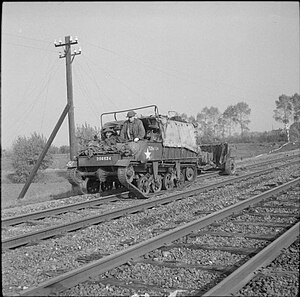Loyd Carrier
| Loyd Carrier | |
|---|---|

Loyd TT towing a 6 Pdr anti-tank gun, outside 's-Hertogenbosch 1944
|
|
| Type | Armoured personnel carrier |
| Place of origin | United Kingdom |
| Service history | |
| In service | 1939 -1960s |
| Used by |
British & Commonwealth. |
| Wars | Second World War |
| Production history | |
| Designer | Vivian Loyd |
| Designed | 1939 |
| Manufacturer | Vivian Loyd & Co, and others (see text) |
| Produced | 1939 - |
| No. built | 26,000 |
| Variants | Mark 1, Mark 2 |
| Specifications | |
| Weight | 4.50 t (4.43 long tons) |
| Length | 13 ft 11 in (4.24 m) |
| Width | 6 ft 9 in (2.06 m) |
| Height | 4 ft 8 in (1.42 m) |
| Crew | 1 |
|
|
|
| Armour | up to 7 mm where fitted |
|
Main
armament |
unarmed |
| Engine |
Ford V8 Side-valve petrol 85 bhp (63 kW) |
| Power/weight | 18.9 hp/tonne |
| Payload capacity | 7-8 passengers or similar load |
| Transmission | Ford 4 forward, 1 reverse gearbox |
| Suspension | Horstmann twin wheel bogies |
| Ground clearance | 8 inches |
| Fuel capacity | 22 gallons |
|
Operational
range |
140 miles (220 km) on roads |
| Speed | 30 mph (48 km/h) maximum on road |
|
Steering
system |
braked - two drums per track |
British & Commonwealth.
The Loyd Carrier was one of a number of small tracked vehicles used by the British and Commonwealth forces in the Second World War to transport equipment and men about the battlefield. Alongside the Bren, Scout and Machine Gun Carriers, they also moved infantry support weapons.
The Loyd Carrier was built upon the mechanicals (engine, gearbox and transmission) of a 15 cwt 4x2 Fordson 7V truck with mild steel bodywork to which armour plate (referred to as 'BP Plate' in Loyd manuals) was bolted (to the front and upper sides) depending on application. The engine was at the rear of the Carrier with the radiator behind rather than in front. The transmission then took the drive forward to the axle at the very front where it drove the tracks. Both the front drive sprockets and idlers (which were also sprocketed) at the rear of the tracks were fitted with brakes, actuated by a pair of levers by the driver. To turn the vehicle to the left, the brakes were applied on that side and the Carrier would slew round the stopped track.
The upper hull covered the front and sides but was open to the rear and above; as the Carrier was not expected to function as a fighting vehicle this was not an issue. To protect the occupants from the weather a canvas tilt could be put up; this was standard fitment from the factory.
As part of the rapid development program and use of pre-designed parts the Loyd used parts from other vehicles. From the Universal Carrier the track, drive sprockets, and Horstmann suspension units. From the Fordson 7V, the chassis, engine, gearbox, torque tube and front axle. The brake drums and back plates were designed specifically for the Loyd.
The Army tested the Loyd Carrier in 1939 and placed an initial order for 200 as the Carrier, Tracked, Personnel Carrying i.e. a personnel carrier. Initial deliveries were from Vivian Loyd's own company but production moved to the larger firms including the Ford Motor Company and Wolseley Motors (13,000 between them) and Dennis Brothers Ltd, Aveling & Barford and Sentinel Waggon Works. Total production of the Loyd Carrier was approximately 26,000.
...
Wikipedia
